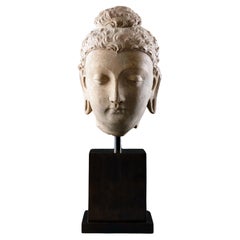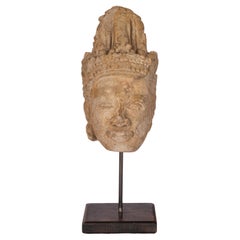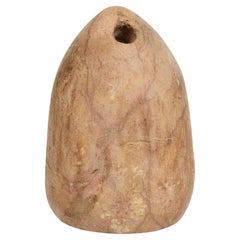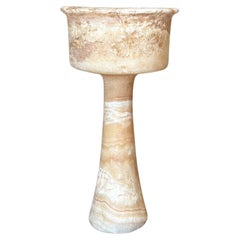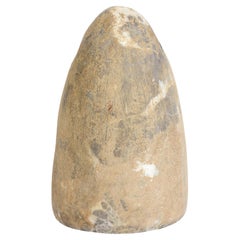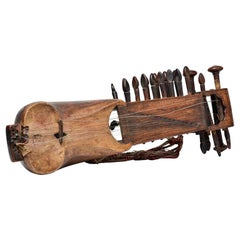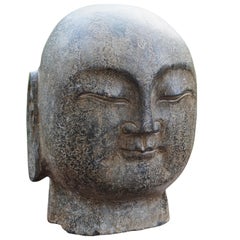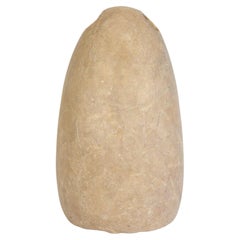Central Asian Antiquities
18
to
7
8
8
18
18
18
1
15
1
2
1
1
6
4
4
2
2
9,514
1,615
1,117
764
312
Place of Origin: Central Asian
A Fine Gandharan Head of a Buddha
Located in London, GB
A Fine Gandharan Head of a Buddha
Stucco with ‘earth pigment’
Some old ‘restoration’ to the nose
Afghanistan
3rd Century AD
Size: 26cm high, 14.5cm wide, 14cm deep - 10¼ ins hig...
Category
15th Century and Earlier Antique Central Asian Antiquities
Materials
Stucco
Ancient Gandharan Carved Stucco Greco Buddhist Bodhisattva Head Bust 400-500 CE
Located in Portland, OR
An ancient Gandharan carved stucco head, 4th-5th Century CE.
This carved stucco head represents a Bodhisattva wearing an elaborate headdress, raised on a custom steel stand.
The anci...
Category
15th Century and Earlier Archaistic Antique Central Asian Antiquities
Materials
Stucco
2-3 B.C., Afghanistan, Rare Bactrian Hardstone Weight
Located in Sampantawong, TH
Rare Bactrian hardstone weight with creamy stone color and 2 holes on the top, the base is flat. In the ancient time, the two holes were used to tie up with rope and measure the weig...
Category
15th Century and Earlier Antique Central Asian Antiquities
Materials
Stone
Large Bactrian Bronze Age Alabaster Chalice
Located in Vosselaar, BE
Bactrian alabaster chalice, circa 3000-2000 BC. It has an elegant tapering formed base with a undeep rimmed cup. The alabaster is strikingly vained. ...
Category
15th Century and Earlier Archaistic Antique Central Asian Antiquities
Materials
Alabaster
2-3 B.C., Afghanistan, Rare Bactrian Hardstone Weight
Located in Sampantawong, TH
Rare Bactrian hardstone weight with creamy stone color and 2 holes on the top, the base is flat. In the ancient time, the two holes were used to tie up with rope and measure the weig...
Category
15th Century and Earlier Antique Central Asian Antiquities
Materials
Stone
Old Rare Afghan Musical Instrument like a Sculpture
Located in Alessandria, Piemonte
Lovely old "Saranji", rare Afghan musical instrument. It's an oriental lute from Naxçivan, the town which owes its origine to the tribe Nakh. In Your home it may be like a sculpture ...
Category
Mid-18th Century Other Antique Central Asian Antiquities
Materials
Fruitwood
Ancient Antique Carved Marble Greco-Bactrian Hippocampus Horse 2nd Century BC
Located in Portland, OR
A rare Greco-Bactrian alabaster carving of a Hippocampus (Hippocamp) from antiquity, Central Asia or Afghanistan, circa 200 BCE.
Finely carved from banded alabaster as a hippocampus ...
Category
15th Century and Earlier Classical Greek Antique Central Asian Antiquities
Materials
Alabaster
Antique Ikat Dyed Uzbek Silk Robe
Located in Delray Beach, FL
Beautiful bright and colorful Antique Ikat silk Dyed Uzbek Robe. Has minor wear and tear shown in photos. Colors: Fuchsia, light pink, purple, yellow and bl...
Category
1920s Vintage Central Asian Antiquities
Materials
Silk, Cotton
Uzbekistan, Tajikistan: a Rare, Old ‘Bridal Crown’ 20th Century
Located in Madrid, ES
Uzbekistan, Tajikistan: a rare, old ‘bridal crown’ made of silver, gilded in parts, with turquoise coloured ornamental stones, glass, coral, and many pend...
Category
20th Century Modern Central Asian Antiquities
Materials
Silver
Gandharan Small Stucco Buddha Head, Style of Hadda, 5th-6th Century
Located in Austin, TX
A lovely small stucco head of the Buddha, ancient region of Gandhara, probably Hadda, 5th to 6th century, modern day Afghanistan.
Beautifully rendered, the small Gandharan Buddha...
Category
15th Century and Earlier Antique Central Asian Antiquities
Materials
Stucco
Ancient Bactrian Marble Idol Staff Sceptor
Located in Vosselaar, BE
A large Bactrian marble staff circa late 3rd-2nd millennium BCE. The Bactrian culture was discovered by Soviet archeologists in the 1970s in Afghanistan. Also called the Oxus culture...
Category
15th Century and Earlier Antique Central Asian Antiquities
Materials
Marble
Rare Samarkanda or Bokara Almoner Trays
Located in Alessandria, Piemonte
Very antique and rare almoner trays from Samarkanda or Bokara - Ghaznevide Dinasty from 11th-12th century A.D.
Interesting for Your desk!
From private collection -
O/1655.
Category
15th Century and Earlier Other Antique Central Asian Antiquities
Materials
Copper
Bactrian Marble Column Idol
Located in Vosselaar, BE
Bactrian marble column idol, circa 3000-2000 Bc. It has a elegant tapering form with a undeep groove running on the top and bottom. The marble is a breccia type with striking vains i...
Category
15th Century and Earlier Archaistic Antique Central Asian Antiquities
Materials
Marble
A Stucco Torso of the Buddha, Gandhara, 4th-5th Century
Located in Dallas, TX
PRESENTING a STUNNING piece of Indian Antiquity from circa the 4th-5th Century, namely, A Stucco Torso of the Buddha, Gandhara.
Ancient Gandhara is located in the rugged foothills of the Himalayas in what is today northwest Pakistan and eastern Afghanistan, was for centuries a thriving center of trade along the Silk Road linking China, South Asia, and the Mediterranean.
The piece was purchased by a Private Collector at Sotheby’s, or more probably, Christies of New York Auction pre-2000. The paper label on the wooden base is “7281/465” for Sale Number 7281, Lot No. 465.
Sotheby’s and Christies operate a twice yearly auction of Southeast Asian Art & Antiquities in New York in the months of March and September.
The Sale Number is more like a ‘Christies;’ Sale Number but we cannot locate any records for this sale online as it was pre-2004.
The sculpture is a Gandharan stucco headless bust...
Category
15th Century and Earlier Medieval Antique Central Asian Antiquities
Materials
Stucco
Antique Entrance Door in Green Lacquered Wood, Ethnic Style, 1700
Located in Cuneo, Italy (CN)
Antique entrance door in green lacquered wood with a very sculpted and deep frame, sculpted with 8 panels by hand with motifs typical of the Asia...
Category
18th Century Antique Central Asian Antiquities
Materials
Wood
Antique 1870s Persian Samarkand Khotan Rug, 7' x 14'
Located in New York, NY
This white Samarkand Khotan carpet consists of a cotton warp and weft, hand-knotted pure wool pile and organic vegetal dyes. Created circa 1870, its unique coloration, age and fine q...
Category
1870s Khotan Antique Central Asian Antiquities
Materials
Wool
Bactrian Ritual Object
Located in Coral Gables, FL
Bactrian culture, Afghanistan. 3rd or early 2nd Millennium B.C.
Category
15th Century and Earlier Other Antique Central Asian Antiquities
Bactrian Ritual Object
Located in Coral Gables, FL
Bactrian ritual object, Bactrian culture, Quetta, Afghanistan 3rd or early 2nd Millennium B.C.
Category
15th Century and Earlier Other Antique Central Asian Antiquities
Related Items
Rare Yue Celadon-Glazed Vessel, Jin dynasty (265-420)
Located in seoul, KR
A Yue celadon vessel from the Jin Dynasty period, notable for its characteristic greenish-glazed pottery which was prominent during this time. The vessel features a globular body wit...
Category
15th Century and Earlier Han Antique Central Asian Antiquities
Materials
Stoneware
Rare Hand Carved Antique Japanese Marble or Granite Buddha Head Sculpture
Located in Lisse, NL
Stunning and one of a kind Buddha sculpture.
There are only very few people in the world who can accurately date this hand carved marble or granite Japanese Buddha head...
Category
Early 20th Century Central Asian Antiquities
Materials
Marble
Free Shipping
H 8.65 in W 6.3 in D 7.1 in
10/11C Pot-Bellied Vishnu Buff Sandstone Sculpture
Located in Dallas, TX
PRESENTING a STUNNING piece of Southeast Asian Antiquity, namely, a 10/11C Pot-Bellied Vishnu Buff Sandstone Sculpture from Central India.
This piece has impeccable Provenance!
So...
Category
15th Century and Earlier Archaistic Antique Central Asian Antiquities
Materials
Sandstone
Ancient Antique Luristan Bronze Sword / Knife / Dagger / Early Iron Age Weapon
Located in Sampantawong, TH
Ancient Luristan bronze sword with green patina.
Luristan bronze comes from the province of Lorestan, a region of nowadays Western Iran in the Zagros Mountains. With its rich and lo...
Category
15th Century and Earlier Antique Central Asian Antiquities
Materials
Bronze
H 26.19 in W 1.78 in D 2.17 in
Set of Four Egyptian Antiquities, Pair of Sarcophagus Faience & Two Figurines
Located in New York, NY
This captivating authentic Egyptian Faience set was realized in ancient Egypt circa 3100 BCE. It offers two sarcophagus figurines- suggestive of miniature versions of King Tut's tomb- hand finished in a beautiful turquoise hue (a glaze created by pulverizing the stone into pigment). Additionally, the set features two figurines (one representative of the Egyptian god Anubis), and the other seemingly a depiction of one of the ruler's as a young child also in a turquoise glaze atop volumetric rhombus plinths with tapered sides in a refined terra cotta hue. Full of historical importance (and stunning as stand alone objects) this collection of Egyptian antiquities...
Category
15th Century and Earlier Egyptian Antique Central Asian Antiquities
Materials
Faience
H 2 in W 1.25 in D 1.25 in
Ancient Antique Luristan Bronze Sword / Knife / Dagger / Early Iron Age Weapon
Located in Sampantawong, TH
Ancient Luristan bronze sword with nice patina.
Luristan bronze comes from the province of Lorestan, a region of nowadays Western Iran in the Zagros Mountains. With its rich and lon...
Category
15th Century and Earlier Antique Central Asian Antiquities
Materials
Bronze
H 23 in W 1.66 in D 0.36 in
Ancient Antique Luristan Bronze Spear Early Iron Age Weapon
Located in Sampantawong, TH
Ancient Luristan bronze spear with excellent green patina.
Luristan bronze comes from the province of Lorestan, a region of nowadays Western Iran in the Zagros Mountains. With its r...
Category
15th Century and Earlier Antique Central Asian Antiquities
Materials
Bronze
Ancient Antique Luristan Bronze Spear Early Iron Age Weapon
Located in Sampantawong, TH
Ancient Luristan bronze spear with excellent green patina.
Luristan bronze comes from the province of Lorestan, a region of nowadays Western I...
Category
15th Century and Earlier Antique Central Asian Antiquities
Materials
Bronze
Uzbekistan, Tajikistan: a Rare, Old ‘Bridal Crown’ 20th Century
Located in Madrid, ES
Uzbekistan, Tajikistan: a rare, old ‘bridal crown’ made of silver, gilded in parts, with turquoise coloured ornamental stones, glass, coral, and many pend...
Category
20th Century Modern Central Asian Antiquities
Materials
Silver
Large Carved Chinese Marble Bust Head of Guanyin Buddhist Bodhisattva Sculpture
Located in Studio City, CA
Beautiful marble Quan Yin. Very large and incredibly heavy (needs additional padding on the underside or a stand to help balance the bust so that it ca...
Category
20th Century Central Asian Antiquities
Materials
Marble
H 17 in W 10.5 in D 8 in
Khmer Sandstone Buddha Shiva Head 11th Century
Located in Dallas, TX
A sandstone figure head of Shiva Khmer, Baphuon style, circa 11th century. A rare Khmer gray sandstone head of Shiva. The handsome head of the divinity deity Shiva. His face with serene expression, almond-shaped eyes, ridged eyebrows and elongated earlobes, His headdress in tight rows and piled in tresses at the top of the head.
Provenance: From a Canadian auction selling the estate of a French gentleman who amassed a large collection of Gandhara, Buddhas and Khmer items throughout his life.
Measures: Head: 8 x 4.5 x 4.5 inches (20.5 x 11.4 x 11.4 cm)
With stand: 10.7 inches tall
Similar to item at Christies SALE 2828, Lot 1124 Indian and Southeast Asian Art 19, March 2014, New York.
Shiva ( Siva, lit. the auspicious one) also known as Mahadeva ( lit. the greatest god) is one of the principal deities of Hinduism. He is the Supreme Being within Shaivism, one of the major traditions within contemporary Hinduism.
Shiva is known as "The Destroyer" within the Trimurti, the Hindu trinity that includes Brahma and Vishnu. In Shaivism tradition, Shiva is the Supreme being who creates, protects and transforms the universe. In the tradition of Hinduism called Shaktism, the Goddess, or Devi, is described as supreme, yet Shiva is revered along with Vishnu and Brahma. A goddess is stated to be the energy and creative power (Shakti) of each, with Parvati (Sati) the equal complementary partner of Shiva.
He is one of the five equivalent deities in Panchayatana puja of the Smarta tradition of Hinduism. According to the Shaivism sect, the highest form of Shiva is formless, limitless, transcendent and unchanging absolute Brahman,[16] and the primal Atman (soul, self) of the universe. There are many both benevolent and fearsome depictions of Shiva. In benevolent aspects, he is depicted as an omniscient Yogi who lives an ascetic life on Mount Kailash[1] as well as a householder with wife Parvati and his two children, Ganesha and Kartikeya. In his fierce aspects, he is often depicted slaying demons.
Shiva is also known as Adiyogi Shiva, regarded as the patron god of yoga, meditation and arts. The iconographical attributes of Shiva are the serpent around his neck, the adorning crescent moon, the holy river Ganga flowing from his matted hair, the third eye on his forehead, the trishula or trident, as his weapon, and the damaru drum...
Category
15th Century and Earlier Antique Central Asian Antiquities
Materials
Sandstone
Ancient Antique Luristan Bronze Sword / Knife / Dagger / Early Iron Age Weapon
Located in Sampantawong, TH
Ancient Luristan bronze sword with nice patina.
Luristan bronze comes from the province of Lorestan, a region of nowadays Western Iran in the ...
Category
15th Century and Earlier Antique Central Asian Antiquities
Materials
Bronze
H 26.86 in W 1.54 in D 3.15 in
Previously Available Items
Set of 2 Bactrian Stone Aniconic Idols
Located in Vosselaar, BE
A pair of carved limestone ovoid or aniconic idol with distinctive holes to the narrow end. Lovely color and patina. Rare to find a matching pair. Fine condition.
Bactrian culture, c...
Category
15th Century and Earlier Archaistic Antique Central Asian Antiquities
Materials
Marble
2-3 B.C., Afghanistan, Rare Bactrian Hardstone Weight
Located in Sampantawong, TH
Rare Bactrian hardstone weight with creamy stone color and 2 holes on the top, the base is flat. In the ancient time, the two holes were used to tie up with rope and measure the weig...
Category
15th Century and Earlier Antique Central Asian Antiquities
Materials
Stone
2-3 B.C., Afghanistan, Rare Bactrian Hardstone Weight
Located in Sampantawong, TH
Rare Bactrian hardstone weight with creamy stone color and 2 holes on the top, the base is flat. In the ancient time, the two holes were used to tie up with rope and measure the weig...
Category
15th Century and Earlier Antique Central Asian Antiquities
Materials
Stone
2-3 B.C., Afghanistan, Rare Ancient Antique Bactrian Hardstone Weight
Located in Sampantawong, TH
Rare Bactrian hardstone weight with creamy stone color and 2 holes on the top, the base is flat. In the ancient time, the two holes were used to tie up with rope and measure the weig...
Category
15th Century and Earlier Antique Central Asian Antiquities
Materials
Stone
Small Bactrian Mottled Marble Cup
Located in Vosselaar, BE
Bactrian Alabaster offering vessel, second millenium BC, A small veined alabaster vessel with assymetric waisted cylindrical form. The interior half way down in a U bouwl. Composite ...
Category
15th Century and Earlier Antique Central Asian Antiquities
Materials
Alabaster
Small Bactrian Alabaster Offering Vessel
Located in Vosselaar, BE
Bactrian Alabaster offering vessel, second millenium BC, A small veined alabaster vessel with assymetric waisted cylindrical form. The interior half wa...
Category
15th Century and Earlier Antique Central Asian Antiquities
Materials
Alabaster
Bactrian Alabaster Aniconic Idol
Located in Vosselaar, BE
A carved alabaster ovoid or aniconic idol with distinctive hole to the narrow end. 10.3 kg, 22cm (8 3/4"). Fine condition.
Bactrian culture, circa 2nd millennium B.C.
The Bactrian culture existed between the 3rd millennium B.C. and the 6th century in Central Asia comprising modern Afghanistan and bordering India. Its origins as a bronze age civilization was only recently (1970s) discovered by Russian archaeologist. And it was only in the 1990s that Western countries learned about it.
At its most famous site, the Bactria-Margiana complex, they found an astonishing amount of remains which still is being researched today. Apart from beautiful metal objects a lot of stone idols...
Category
15th Century and Earlier Antique Central Asian Antiquities
Materials
Alabaster
Important Gold Fragment
Located in London, GB
This fragment forms part of the famed Ziwiye hoard of treasure, reputably found in 1947 in modern day Kurdistan. As the contents of a royal tomb of a great ancient king, the pieces were quickly dispersed and only in the following years did the huge significance become understood in scholarship. These objects have become famous as the keystone in explaining underpinning socio-economic and political cultural ties across the silk route, reflected by these works of art. These objects exhibit styles and motifs associated with the four pre-eminent cultures at this juncture in history: Assyrian, Scythian, proto-Achaemenid and the provincial native pieces. The Scythians, a seminomadic people from the Eurasian steppes who moved out from Southern Russia into the territory between the Don and the Danube and then into Mesopotamia are responsible for the basis of an ‘animal style’ design found on the elaborate metalwork and jewellery produced in Central Asian ancient world. This style starts to appear in the 7th century B.C typically on pierced plaques made of gold and silver, which depict running or fighting animals (reindeer, lions, tigers, horses) alone or in pairs facing each other, embossed with powerful plasticity and free interpretation of the forms. The animal- style had a strong influence in western Asia during the 7th century B.C. Such ornaments as necklaces, bracelets, pectorals, diadems, and earrings making up the Ziwiye treasure (discovered in Iran near the border between Kurdistan and Azerbaijan) provide evidence of this Asiatic phase of Scythian gold...
Category
15th Century and Earlier Antique Central Asian Antiquities
Materials
Gold
Sino-Siberian Dagger
Located in London, GB
The nomadic nature of the Eurasian steppe tribes allowed for much integration and exchange of styles and customs, as well as physical transportable objects; including personal ornamentation and weaponry. Particularly between the Scythian tribes of the Black sea region in the West, Central Asian tribes such as the Hephthalites, the Wushu, Yuezhi and Mongolians to the East and the Persians further South. The blade of this piece has strong ties to daggers of the late Chinese Shang...
Category
15th Century and Earlier Antique Central Asian Antiquities
Materials
Bronze
The 'George Sand' Bull
Located in London, GB
The Amlash culture is known almost exclusively through the archaeological record that has come to light in recent decades. The term refers to the material culture found in the modern...
Category
15th Century and Earlier Antique Central Asian Antiquities
Materials
Terracotta
'Damon' Candlestick
Located in London, GB
Resting on a wide, trumpeted foot, this wonderful candlestick rises from a band of chased keyfret motif to a body of open pierced fretwork, which consists of thuluth calligraphy agai...
Category
15th Century and Earlier Antique Central Asian Antiquities
Materials
Copper
Minai Ceramic Jug
Located in London, GB
A polychrome Minai (enamel) handled cup from the latter half of the Turco-Persian Seljuq period (1040 - 1307), most probably from Kashan, a significant centre of ceramics production during this time where potters moulded, fired and painted both Minai and lusterware works. This handled cup rises from a short foot and widens to a spherical body, which tapers towards its neck at its widest point, emphasizing its curvature, and flares slightly at its rim. The artist has painted figures upon horseback, rendered in vibrant colours and outlined in black and gold, on the central frieze that encircles the body. Above the figures runs a blue band of Arabic calligraphy, written in Kufic script, while on the same spot in the interior of the cup there is a band of orange calligraphy, executed again in the Kufic style. The handle is S-shaped with a delicate, pale green scrolling pattern, which couples to underscore its function as a drinking utensil, along with its opulence; a luxurious example of the material culture of pre-Mongol Iran. Minai means enamel in Persian, and the term refers to this type of pottery’s colourful decoration, which lies both in and over the glaze, here further enriched with gold (gilding) which is visible on the horse’s reigns and the bows on their tails. Only certain colours are fixed as over glazed enamels. Some, such as turquoise, blue and purple are normally painted into the opaque white glaze after it has been applied and are fixed with it in the firing. Enamel pigments are then painted, and fixed in the second firing. These are normally restricted to red and black, but in more ambitious pieces, such as in this case, a whole range of other enamel colours are found together with gold gilding. Such Minai works had to be fired twice in order to achieve their polychromatic harmonies and were consequently the most sought-after and costly wares; we can thereby infer that the patron or owner was likely to have been a member of the Seljuq elite. The Seljuqs descended from nomads (specifically the Turkic Oghuz clan) who grazed cattle on the Central Asian land that the previous Persian dynasty...
Category
15th Century and Earlier Antique Central Asian Antiquities
Materials
Ceramic
Recently Viewed
View AllMore Ways To Browse
Lapis Asian Figurine
Bactrian Stone
Antique Viking Pendant
Chinese Opium Pipes
Antique Wooden Hibachi
Greco Bactrian
Haniwa Heads
Desert Samurai
19th Century Burmese Thai Buddha
Samurai Hat
Antique Chinese Corbels
Khmer Torso
Used Polo Boots
Vintage Asian Parasol
Han Dynasty Amphora
Antique Pig Figurine
Antique Pig Figurines
Opium Lamp
